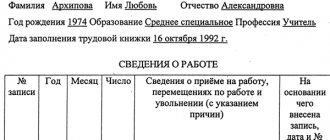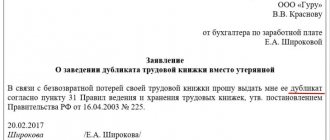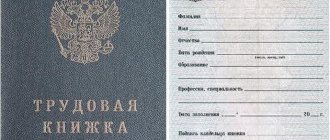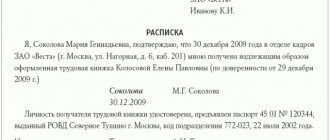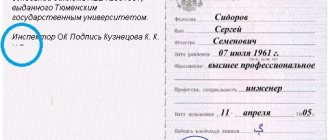19.06.2019
0
3353
5 minutes.
The work book reflects all data on the employee’s production activities. The employer indicates the main points related to work for the further receipt of pension accruals and the availability of information about work experience. The entry in the employment record of the transfer is carried out in accordance with the rules established by law. Any adjustments and changes during the period of employment must be justified by legal regulations. An entry in the work book about a transfer to another position is made within 7 days.
Grounds for entry in the work book
When registering an employee’s transfer, an additional agreement is drawn up. It states:
- temporary or permanent transfer;
- what date to start work;
- name of the new position;
- the name of the new structural organization, if any;
- a complete list of new job responsibilities;
- salary amount;
- additional conditions.
Expert opinion
Mikhailov Vladislav Ivanovich
Lawyer with 6 years of experience. Specializes in family law. Knows everything about the law.
Both copies are signed by the manager and employee. In the manager’s copy, the employee makes a note that the second copy was received in person and signs.
After signing the additional agreement, the head of the organization must write an order on the unified T-5 form indicating the reason for the transfer. This order is delivered to the employee against signature.
It is then sent to the HR department for processing. The personnel officer fills out the card according to the T-2 form. It states the date, new position, salary or wages, order details and the employee signs. And only after that the work book is filled out.
Important. If the organization where a person works or will work is located in the regions of the Far North or equivalent to it, an entry about this must be made in the work book.
If there is no such mark, then when you retire and accrue your pension experience, many questions will arise about northern benefits.
How to write temporary in documents: in capital or small letters
When preparing official documents, it is important to correctly indicate all details. One of them is the signature of the manager. But sometimes, in the temporary absence of the manager, the right to sign is transferred to another person - the acting manager.
In such a situation, its validity depends on the correct execution of the document. Let's look at how to do everything as competently as possible.
In office work, two abbreviations are used to designate an employee who has the right to sign on documents instead of an officially appointed manager: acting. and acting
That is, acting and interim. But the legislation makes no mention of them. There is no consensus on how to correctly write such abbreviations. So maybe such designs are completely illegal? Let's figure it out.
Legal basis
Instructing one of the employees to perform the duties of a colleague responsible for various reasons in addition to his own is regulated by Art. 60.2 Labor Code of the Russian Federation. To do this, an appropriate agreement is concluded with the employee and an order is issued to assign additional work.
There are no restrictions in the article on the performance of managerial duties according to this scheme. But it is in the by-law, more precisely in the Explanation of the USSR State Committee for Labor of 1965, which is still in effect.
It says that such combination is allowed only if the manager is appointed to the temporarily assigned position by a higher authority.
This is not the only option for temporarily filling a management vacancy. You can use it:
- complete the translation (Article 72.2 of the Labor Code of the Russian Federation);
- move an employee (Article 72.1 of the Labor Code of the Russian Federation);
- accept someone under a fixed-term contract (Article 59 of the Labor Code of the Russian Federation).
However, in all these cases there is one small nuance. Such employees will not be considered acting as managers. They will be the leaders. This should be reflected in the documents accordingly. Therefore, these options do not apply to our case.
In what cases is io used?
An acting person is appointed when the position of a manager is vacated. There can be many reasons:
- personal desire of the former leader;
- decision of the founder or higher authorities;
- transfer of a manager to another position;
- etc.
Regardless of the reason, the consequence is the opening of a managerial vacancy. Finding a suitable candidate takes some time. But production and management processes cannot wait; they need to be formalized with appropriate administrative documents. Therefore, the performance of the manager’s duties in full is entrusted to another person. As a rule, this is the first deputy.
Until he is confirmed in the position on a permanent basis or until a more suitable candidate is appointed to it, such an employee is considered to be acting as the main person of the company.
Such an appointment is formalized by an additional agreement and order. But no entry is made in the work book about such an appointment.
In what cases is temporary written?
The manager himself can entrust the temporary performance of his duties to his deputy or someone else. For example, when going on vacation, on a long business trip, or when sick. That is, in those situations when, after some time, the manager returns to his work.
The order must be formalized by an organization order. It indicates the time frame of the assignment in the form of specific dates or the wording “for the period of absence” if it is not known exactly when it will end.
If during the absence of management it is expected that financial documents or agreements with counterparties will be signed, then a copy of the order is sent to the bank and the management of the partner company.
No entry is made in the work book of the acting employee. But an additional agreement, which, among other things, indicates the amount of the surcharge, must be concluded.
How to write acting and acting correctly. in documents
The existing division in office work into “acting” and “acting.” very conditional. After all, in both cases the duties are performed temporarily.
However, it is generally accepted that “acting” is written before the position of the person acting as director during his vacation or illness. And to reflect the fact of an open managerial vacancy, the abbreviation “acting” is used. There are also differences in their spelling.
When temporarily transferring management functions and signing rights by the general director himself, the authorized person can use two options for signing:
- That’s how to write acting director A.B. Petrov;
- use the name of your own position - first deputy director V.G. Sidorov.
Please note that vrio is written with a small letter and without any periods between them . This option is considered the only correct one. This acronym is written with a capital letter only when it appears at the beginning of a sentence: “The Acting Reflected in his report...”
A reduction in the transfer of a leadership position before the official appointment of a new leader is a different matter. Here it is necessary to indicate the official status of the acting official.
Therefore, on all documents only the name of the position being filled is used. The writing principle is also different; the abbreviation also uses small letters, but dots are placed after them: “i.o.
»
Features of international correspondence
In business correspondence, the status of the employee as a temporary replacement manager is also indicated. For this, the following English expressions and their abbreviations are used:
- Officer-in-Charge of the (position name) for acting;
- Director General ad Interim or Director General ai for interim;
- acting head (job title) or simply acting as+position for acting.
How to make an entry in the work book about a transfer to another position: instructions
All notes are made in pen. The numbers are written in Arabic.
- A blank line is indented from the last entry.
- The first column is where the serial number is written.
- Third, a brief note is made about the employee’s transfer. Begins with the entry “Transferred”. “If the position belongs to the category of managers and specialists, then we write “.” for the position. “If it is for the category of workers, then it is not written. We indicate the name of the position and, if necessary, the name of the structural unit.
- Fourth – the word order is written without abbreviations, the date and number of the order.
It often happens that even HR department employees confuse the concepts of transfer and relocation of an employee to another place. The fact is that when moving, the employee’s consent is not required.
The employee simply moves to another job in the same company. At the same time, he holds the same position, without changing qualifications, wages, or working conditions.
Throughout your working life, pay close attention to documents confirming your work experience. Monitor every entry when any changes occur at work.
Let's look at the sequence of translation of a work book - what you need to pay attention to.
Translation of work books issued in Russia
Work books issued / processed in Russia will be in Russian - we have office work in the official language.
We believe that our client needs a translation from Russian into one of the main foreign languages.
The main and main point is to find out the registration requirements from the receiving party. If you submit a translation to the embassy, in what form do they need the translation? If you are sending a finished translation outside of Russia, in what form do they want to receive the document?
You can submit either a regular copy of the work record book or a certified copy. A certified copy can be of two types: certified by a notary and certified by the human resources department at the place of work.
A notarized copy can be made if the book is “closed” - the last entry must be about the dismissal. If the last entry is not about dismissal, the notary will not be able to make a copy, because
The original work permit must be kept by the employer. If your employment record is currently kept by your employer, the HR department will prepare a copy for you: the copy will be certified by the organization’s seal, and on the last page there will be the entry “Currently working” or a similar entry.
Expert opinion
Mikhailov Vladislav Ivanovich
Lawyer with 6 years of experience. Specializes in family law. Knows everything about the law.
Your assistance may be needed in translating the names of firms and organizations where you previously worked - these firms and companies may have approved names in English/German/French.
Translation time and cost
Select the language into which you want to translate the work book to determine the timing and cost of translation:
As an example, let's take a book issued in 1978 in Tbilisi. Some of the recordings will be in Russian, some in Georgian.
What to do? Where to begin? We find out from the customer what language the translation is needed.
If you need it in Russian, it means the book will be used in Russia. We find out from the customer whether certain points need to be translated or whether the entire document needs to be translated. We find out by certification - to certify it with a notary or with the seal of a translation agency.
We found out everything and got to work. We make a regular copy, translate it into Russian, and have the finished translation certified by a notary.
If it turns out that translation is needed into English, it means that the work book will be used outside of Russia. We find out from the customer whether certain points need to be translated or whether the entire work needs to be translated. We find out by certification - to certify it with a notary or with the seal of a translation agency.
If all the questions have been answered, let’s get started. First, we translate from Georgian into Russian, then we translate the resulting document from Russian into English. It is impossible to directly translate from Georgian into English - the notary will not certify the translation.
Translation of corrections in the work book
Corrections can be found in work books. These could be mistakes made when filling out the work book - for example, they made a mistake with the date of hire. There are planned corrections - for example, if an employee changed his last name. In this case, the HR department makes changes and certifies with a signature and seal.
The translation is done in a standard way - the erroneous/corrected fragment is translated, it is crossed out in the translation, then the actual data is translated. At the very end, the seal of the organization and the data of the employee who made the correction are translated.
Why us?
We have been translating documents for many years and know our work well. Our task at the moment is to make contacting us as convenient and profitable as possible for our clients. We offer:
- order fulfillment in a short time;
- affordable prices;
- various payment options;
- convenient online interaction;
- wide range (translation, notarization, legalization).
In addition, we save completed translations, which means that if you need to re-translate your work book due to making a new entry, the cost of the service and the time it takes to complete the work will be much less for you!
All the main nuances and rules for making certain entries in the work book, including the answer to the question of how to write a transfer to another position in the work book, are contained in the following regulatory documents:
- Rules for maintaining and storing work books, producing book forms and providing them to employers, approved by Decree of the Government of the Russian Federation of April 16, 2003 No. 225>
- Instructions for filling out, approved by Resolution of the Ministry of Labor of the Russian Federation dated October 10, 2003 No. 69.
When entering information into employee work books, the employer should strictly adhere to the established general rules, which are enshrined in the above regulations.
However, before entering any information regarding the employee’s activities, it is necessary to first determine which provision of the law served as the basis for formalizing the corresponding changes.
Transfer to another job
Since the work book is the main document that records information about the owner’s work activities, its completion requires special care. If errors are made in this document, there may be unpleasant consequences when applying for a pension and calculating length of service.
Making a record that a transfer to another position has been made in the work book has some features that you should pay attention to.
Definition of the term
In accordance with Article 70.1 of the Labor Code of the Russian Federation, transfer should be understood as a permanent or temporary change in the employee’s labor function. The transition can be carried out either in the case of continuing work with the same employer or in case of a change.
In fact, there is a change in the initial terms of the work contract determined by the parties, the signs of which are:
- Change in the labor function of an employee (position, specialty, qualification)>
- Changes in working conditions.
Reasons
The issuance of a corresponding order is legal only if there is the written consent of the employee or the circumstances provided for by law.
Obtaining the employee’s consent is not required if the reason for changing the initial terms of the work contract determined by the parties is the occurrence of emergency situations that threaten people’s lives, for example: natural (man-made) disaster, accident, accident, fire, flood, famine, earthquake, epidemic and etc.
Expert opinion
Mikhailov Vladislav Ivanovich
Lawyer with 6 years of experience. Specializes in family law. Knows everything about the law.
Entries about transfer to another job are not made in the work book when, due to downtime or other emergency circumstances, an employee is transferred for a period of up to one month without obtaining his consent.
The employee’s request, stated in writing, or his consent also makes it possible to arrange a transfer to a permanent place of work with another employer.
Based on the nature of the changes being implemented, permanent and temporary transfers of employees can be distinguished.
Temporary transfers are carried out by agreement of the parties, set out in writing. The reason for such a procedure may be to replace an absent employee.
The duration of the replacement can be up to one year or limited to the moment the main employee starts working. In any case, the corresponding entry in the work book about the transfer to a position should only be present if the new job is permanent (Article 66 of the Labor Code of the Russian Federation).
Constant translations, in turn, can be divided into:
- Internal - formalized by changing the terms of the work contract and within the same employer>
- External – carried out by terminating the employment agreement and changing the employer.
Differences between translation and displacement
Some employers do not distinguish between the concepts of transfer to another job and relocation. Despite the fact that these concepts are regulated by one article of the Labor Code of the Russian Federation —>
72.1, there are significant differences in their application. The most basic of them is that the employee’s consent is not required when moving. Relocation can only be carried out within one organization to another workplace. The condition of the transfer is the immutability of the position and specialty determined by the terms of the contract.
When moving employees, the transfer to another position is not recorded in the work book, since in accordance with Part 4 of Art. 66 of the Labor Code of the Russian Federation, only information is subject to entry on the condition that the new workplace will be permanent.
Despite the fact that the employee’s consent is not required when moving, it is prohibited to register him for a job that is contraindicated for him due to poor health.
Types of translations and differences between them
Before talking about the types, we note that any transfer is possible only with the consent of the employee. It can be done at the request of the employee, but with the consent of the employer.
Exceptions can only be made in cases provided for by law. These are force majeure circumstances associated with natural disasters, as well as posing a threat to people’s lives and the possibility of downtime. In such circumstances, the employee's consent is not required. You can transfer without consent for a period of one month.
Temporary transfer. This is done with the consent of the employee within the enterprise where he works. This is possible to replace the main employee during a long vacation, maternity leave or the need for long-term treatment.
An offer may also be made to the employee for the purpose of providing him with a probationary period, with the intention of his further transfer to a new position.
No entry is made in the work book about temporary transfer.
In accordance with Art. 66 of the Labor Code of the Russian Federation the following data is entered:
- Hiring, position;
- Transfer to a permanent place of work;
- dismissal;
- incentives;
- training;
- service in the army, Ministry of Emergency Situations, Ministry of Internal Affairs.
Interior. Carried out within one enterprise. It is usually done for the purpose of promoting an employee or increasing wages associated with changes in working conditions.
Can be done in the area of work where a person directly works. But this may be another structural unit (workshop, site, department) belonging to the same organization without a change of employer.
At the same time, another entry is made in the work book, without indicating the organization.
Job details
date
External. Transfer of an employee to another organization with a change of employer. In this case, the agreement of both managers and the employee who moves from one organization to another is necessary.
This is important to know: Application for storage of a work record book with an employer
A record of dismissal is made in the work book in connection with a transfer to another place of work with the consent of the employee and the approval of the managers.
The receiving organization makes a record of hiring a transfer with the consent of the employee and managers.
Job details
date
| Job details | |||||
| № | date | Information about admission and dismissal | Date and order number | ||
| Number | Months | Year | |||
| Khasyn geological exploration party | |||||
| (Far North) | |||||
| 1. | 26 | 10 | 2016 | Accepted by senior geologist of the office | Ave. 15k. from 10.25.2016 |
| drilling site department for transfer from | |||||
| Susuman Geological Exploration Expedition | |||||
General rules for filling out labor forms
In order to correctly record a transfer to another position in the work book, you must strictly adhere to the requirements of regulatory documents governing this area. The most general rules that are mandatory to follow include the following:
- All information must be recorded based on the issued order of the manager no later than a week. The exception is information about dismissal, which is entered on the same day.
- All data must correspond to the text of the administrative document.
- All dates must be reflected in Arabic numerals (month and day -> two digits, year -> four digits).
- Any abbreviation of words is prohibited.
- The language in which all information is entered is Russian.
- The book can be kept in another language other than Russian if the second language is the state language of the republic within the Russian Federation, at the location of the employer.
Features and examples of filling out books in special cases
Entries in the work book about a transfer to another position, which is temporary in nature, are not made in the employee’s work book. With regard to transfers to another permanent job, the necessary entries are made as follows.
External Transfer Record
When making an entry in the work book, if an employee is transferred from one entrepreneur to another, it is necessary to enter data on dismissal and hiring in the order of transfer in the section containing information about the work. Information is provided by various organizations. The correct execution of such actions will look like this:
Closed Joint Stock Company "Bochka"
01/1315/2010 Accepted as a repairman. Order from
14 05/14/2012 Dismissed by transfer to the open joint-stock company "ZARA" (OJSC "ZARA") with the consent of the employee, paragraph 5 of part one of article 77 of the Labor Code of the Russian Federation Order dated 05/14/2012 No. 17-k
HR Inspector Signature
Open Joint Stock Company "ZARA"
15 15. 05.2012 Hired to the economic department as a repairman as a transfer from the closed joint stock company "Bochka". Order No. 58-k dated May 15, 2012
Record of internal transfer
Before recording a transfer to another position or another structural unit within the same organization in the work book, you must make sure that a transfer and not a transfer is actually taking place. In this case, the situation is simplified by the same order of making entries. For example, a change of position should be formalized as follows:
Limited Liability Company "Captain"
11 08/15/2012 Admitted to the legal department as a lawyer. Order No. 11-k dated August 15, 2012
12 12/16/2012 Transferred to the position of leading lawyer. Order No. 25-k dated December 16, 2012
In the event that it is necessary to record a transfer to another position in the work book while simultaneously changing the department, the entered data should look like this:
14 08/12/2008 Hired in the advertising department as a manager. Order No. 15-k dated August 12, 2008
13 04/15/2009 Transferred to the commerce department to the position of general manager. Order dated April 15, 2009 No. 24-k
The employer should pay special attention to strict compliance with the stipulated rules when entering information about the activities of employees, since otherwise, he may have difficulties in the future when assigning a pension. A personnel employee must clearly be able to distinguish between which names refer to positions and which to professions, in which cases the word accepted is used, and in which -> appointed.
Procedure for registering employee relocation
Important! The employee relocation notification form from ConsultantPlus is available here
The management of the enterprise has the right to move an employee to another structural unit for production or other reasons, including medical indications. In this case, the conditions for the location of the new place of work in the previous area and the absence of significant changes in the labor function (job responsibilities) must be met:
- To reshuffle a specialist, the head of the enterprise issues an appropriate order, which defines a new job or structural unit for the employee to perform job duties.
- The basis for preparing the order is a report (official) note drawn up by the head of the department or structural unit where the specialist works.
- The document is submitted for consideration to the management of the organization, who affixes a conciliatory resolution, the corresponding date and signature.
If the initiative to move to a new place of work comes from an employee, the latter draws up a written application. The text of the document must contain a request to move the applicant to another unit or to another position, indicating the reasons that necessitated such a procedure. The application must be accompanied by supporting documents or medical reports if there are medical indications for moving the worker.
The application is brought to the attention of the management of the enterprise, which, if agreed, issues an authorization visa, which serves as the basis for preparing the appropriate order for the organization.
The text of the order states:
- position held and name of the department or unit where the applicant works;
- grounds for reshuffle;
- name of the unit or position (according to the staffing table) to which the specialist is transferred.
The specialist must familiarize himself with the prepared order and submit his visa for familiarization.
Important! An additional agreement is not drawn up to the employment agreement with the employee, since there is no change in his main job function. An entry about the employee’s movement is not made in the work book (Article 72 of the Labor Code of the Russian Federation).
General provisions
A record of transfer of an employee to another job is made in three cases:
- if a transfer is made to a new position in the same department of the same employer;
- if a transfer is made to another structural or regional unit of the same employer;
- if a transfer is made to another employer.
As follows from the norms of the Labor Code of the Russian Federation, transfer to another job should be understood as a temporary or permanent change in the labor functions of an employee (structural unit) specified in the work agreement when applying for a job. In this case, the transfer can only be made with the voluntary consent of the employee, set out in the corresponding application to the employer or formalized in the corresponding agreement.
Reasons for transferring employees to another permanent place of work
This type of transfer can be carried out both at the initiative of the employee and the employer, and can also be carried out for the following reasons:
Internal transfer:
- employee's own initiative,
- employee promotion,
- demotion based on certification results,
- reduction of company staff,
- based on a medical report.
External translation:
- transfer to another organization.
Regardless of the reasons for the translation of Art. 72.1 of the Labor Code of the Russian Federation establishes a ban on the transfer of employees to jobs that are contraindicated for them due to health reasons.
The transfer of an employee to another position can be processed only with the consent of the employee, or on his initiative (Articles 72 and 72.1 of the Labor Code of the Russian Federation). The exception is some types of temporary transfers due to the occurrence of emergency circumstances (Article 72.2 of the Labor Code of the Russian Federation), but we will not describe such types of transfers in this article.
Transfer of an employee to another department and location
If a transfer to another unit simultaneously involves a change in the employee’s job function (position or location of work), then the employer must conclude a new employment contract with him and only after that issue an appropriate order.
If the transfer involves moving to another area and is carried out at the initiative of the employer, then he is obliged to notify the employee about this no later than two months in advance. If the employee refuses to move, the employer will be obliged to formalize the dismissal on the basis of the ninth paragraph of Part 1 of Art. 77 of the Labor Code of the Russian Federation and pay severance pay (Article 178 of the Labor Code of the Russian Federation).
Expert opinion
Mikhailov Vladislav Ivanovich
Lawyer with 6 years of experience. Specializes in family law. Knows everything about the law.
When transferring an employee to another position within the same employer, an entry in the work book is made in the same way as when hiring.
Basic rules for recording an employee's transfer
Before talking about the main nuances of transferring to another job, and most importantly about how to make the appropriate entry in the work book, you need to become familiar with the very concept of “transfer”.
You can find an explanation of this term in many textbooks on labor law, but it is better to refer to the original source. Thus, the labor code of our country sets out in detail information regarding what constitutes a translation. This definition is reflected in more detail in Article 72.1.
Labor Code of the Russian Federation, Chapter 12, Article 72. Changes in the terms of the employment contract determined by the parties
Changing the terms of the employment contract determined by the parties, including transfer to another job, is allowed only by agreement of the parties to the employment contract, except for the cases provided for by this Code. An agreement to change the terms of an employment contract determined by the parties is concluded in writing.
Transfer, according to general rules, is a permanent and, in some cases, temporary change in the employee’s immediate labor function, or rather the conditions in which it can be carried out.
A transfer can be a variety of actions, ranging from the transfer of an employee from position to position within an organization and ending with the transfer of an employee to another geographical area. Also, do not forget that the student can be awarded, about which a corresponding entry about the award is made in the work book.
The main rule for translation is legislative support . The transfer should be carried out only in accordance with the presence of a similar article in the labor code that would permit such an action.
Also, in order for an entry in the work book to meet the basic canons of filling out such documents, personnel officers must follow a number of very important rules.
Returning to the order,
the personnel officer must carefully read the text of the document
. The first of these is the knowledge that all information that is included in the work book must be formalized in the form of a local regulatory act, in other words, an order. In the absence of an order for relocation or transfer, the personnel officer simply does not have the right to enter data into the work book. . It is on the basis of what is written in the order that a compiled and condensed entry will be made in the labor report.
Expert opinion
Polyakov Pyotr Borisovich
Lawyer with 6 years of experience. Specialization: civil law. More than 3 years of experience in drafting contracts.
As a general rule, the dates included in the document must correspond to Arabic numerals. Filling out a work book with Roman numerals is prohibited.
This is important to know: Information about disciplinary sanctions in the work book
Explanation in any language other than Russian is also prohibited. It is not so easy to cancel an entry in a work book, and an incorrect example of an entry in a work book about military service is canceled in court. Be careful.
Handwriting should be as neat , neat and understandable as possible.
Abbreviating words in an entry in a work record is simply unacceptable, and although many HR employees allow themselves such liberties, this is a gross violation of the instructions for maintaining and storing work records.
If a citizen working on the territory of Russia is a citizen of another republic that is part of the Federation, then it is allowed to keep entries in the work book in two languages.
Transfer to another employer
The issuance of an order for dismissal by transfer is preceded by agreement on this decision between the two organizations. To do this, the head of a company (institution) interested in transferring an employee sends a letter of request to the head of the company where he is going to transfer.
The request should indicate the date from which the employee is expected to be hired for a new job and his new position. Having received the request letter, the head of the company (institution) where the employee works must obtain his consent to the transfer.
As a rule, a citizen writes a letter of resignation in connection with a transfer, to which is attached a letter of request. In response, the head of the company (institution) from which the citizen is resigning sends his future employer a letter confirming consent to the transfer.
Then the personnel department of the previous organization issues an order to terminate the employment contract in connection with the transfer according to the unified form No. T-8 (grounds - clause 5 of Part.
first st. 77 of the Labor Code of the Russian Federation), closes the employee’s personal card and makes an entry in his work book.
And the personnel service of the new organization draws up an employment contract with the citizen, an order for employment, creates a personal card and makes an entry about the employment in his work book.
There may be differences in the described procedure if the citizen himself asked to be transferred to another organization. In this case, the first link in the chain of approval of the transfer will be the employee’s application. Then his employer must inform in writing about this desire to the head of the organization where the employee intends to move, and obtain his consent.
Then the hiring and dismissal procedure is carried out according to the general rules. But when making a note about dismissal in the work book, you should write that the employee was transferred at his request (and not with his consent).
A transfer to another employer is considered to be the transfer of an employee to any other legal entity. Therefore, if the transfer is carried out, for example, within one group of companies, then it is still formalized through dismissal.
An important nuance: for employees hired by transfer, a test cannot be established (Article 70 of the Labor Code of the Russian Federation).
If you include this condition in the employment contract, it will not apply (Article 9 of the Labor Code of the Russian Federation).
At the same time, the employee’s work book must contain a record of dismissal from the previous organization precisely in the order of transfer (clause 5.
first st. 77 Labor Code of the Russian Federation).
How to fill out a work book during a temporary transfer
This hiring practice is not the most common, but it varies in form. Temporary dispatch may be initiated for a number of reasons:
- Short-term replacement of an authorized employee. Distributed within the enterprise for replacement during maternity leave or sick leave.
- Retraining . Sending to another organization, less often to the parent (head) department of a subsidiary, to improve skills.
- Conclusion of a temporary employment contract . Reception for performing specific tasks.
Attention
When internally replacing a temporarily absent employee, it is enough to enter the order number and information in the information, indicating a short-term replacement.
In cases of sending for retraining to another organization, an entry is made in full, with its name. If the movement is carried out within a structural unit, it is enough to indicate the reason.
When an employee is required in another position for a number of tasks, a temporary cooperation agreement is concluded, which specifies all the conditions of its validity. According to the Rules, the contract must be concluded within the framework of labor jurisdiction, otherwise its action is not regulated by the Labor Code of the Russian Federation.
Attention
It specifies the conditions, incl. reasons and period for termination of cooperation.
With such a transfer of a specialist, information about temporary employment is entered in the work book. The number of the concluded agreement on the basis of which the citizen is assigned to the enterprise is also indicated there. This option of cooperation has the right to terminate ahead of schedule by either party. It is not subject to this Law, and is regulated by Articles 78–81 of the Labor Code of the Russian Federation.


